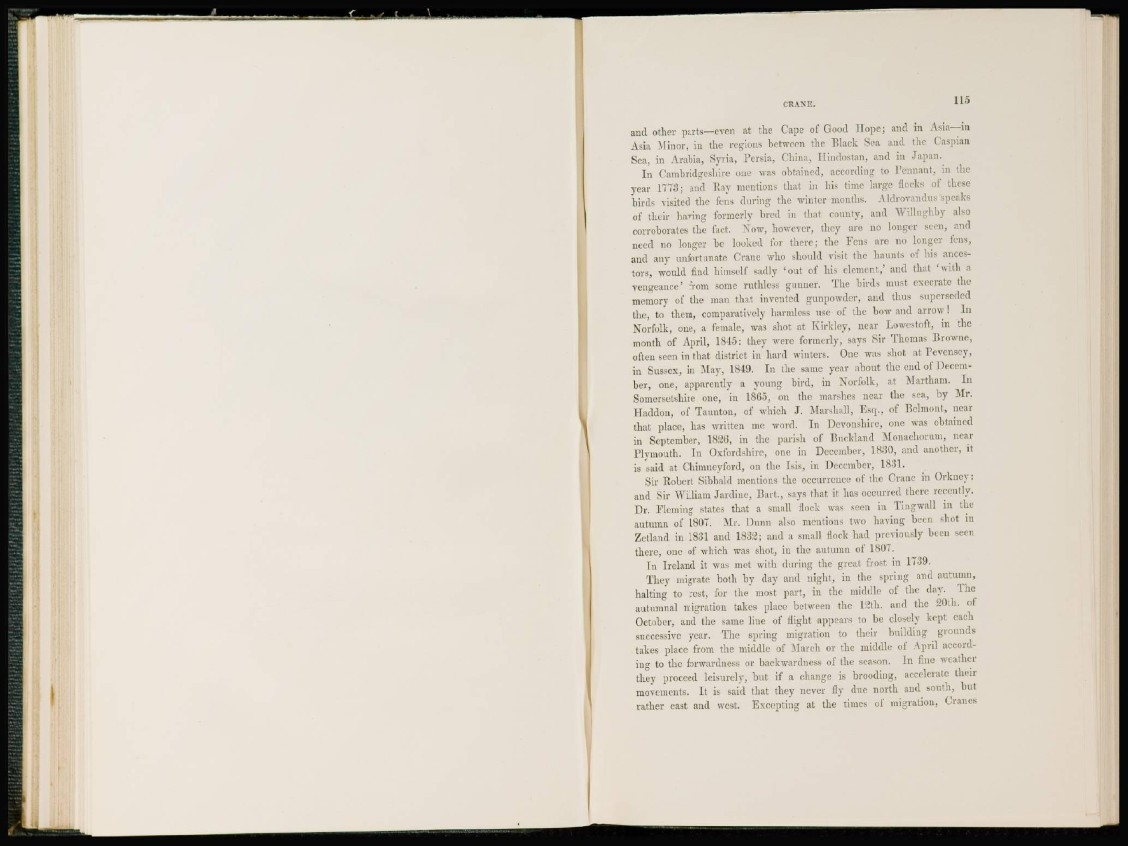
CRANE. 115
and other parts—even at the Cape of Good TTope; and in Asia—in
Asia Minor, in the regions between the Black Sea and the Caspian
Sea, in Arabia, Syria, Persia, China, Hindostan, and in Japan.
I n Cambridgeshire one was obtained, according to Pennant, in the
year 17T3; and Ray mentions that in his time large flocks of these
birds visited the fens during the winter months. Aldrovandus sneaks
of their having formerly bred in that county, and Willughby also
corroborates the fact. Now, however, they are no longer seen, and
need no longer be looked for there; the Fens are no longer fens,
and any unfortunate Crane who should visit the haunts of his ancestors,
would find himself sadly 'out of his clement,' and that 'with a
vengeance' from some ruthless gunner. The birds must execrate the
memory of the man that invented gunpowder, and thus superseded
the, to them, comparatively harmless use of the bow and arrow! In
Norfolk, one, a female, was shot at Kirkley, near Lowestoft, in the
month of April, 1845: they were formerly, says Sir Thomas Browne,
often seen in that district in hard winters. One was shot at Pevcnsey,
in Sussex, in May, 1849. In the same year about the end of December,
one, apparently a young bird, in Norfolk, at Martham. In
Somerset shire one, in I860, on the marshes near the sea, by Mr.
Kaddon, of Taunton, of which J. Marshall, Esq., of Belmont, near
that place, has written me word. In Devonshire, one was obtained
in September, 182b", in the parish of Bnckland Monachmum, near
Plymouth. In Oxfordshire, one in December, 1K30, and another, it
is said at Ohimneyford, on the Isis, in December, 1831.
Sir Robert Sibbald mentions the occurrence of the Crane in Orkney;
and Sir William Jardinc, Bart., says that it has occurred there recently.
Dr. Fleming states that a small Hock was seen in Tingwall in the
autumn of 180T. Mr. Dunn also mentions two having been shot in
Zetland in 1831 and 1832; and a small flock had previously been seen
there, one of which was shot, in the autumn of 1807.
In Ireland it was met with during the great frost in 1739.
They migrate both by day and night, in the spring and autumn,
halting to rest, for the most part, in the middle of the day. The
autumnal migration takes place between the 12th. and the 20th. of
October, and the same line of flight appears to be closely kept each
successive year. The spring migration to their building grounds
takes 2)lace from the middle of March or the middle of April according
to the forwardness or backwardness of the season. In fine weather
they proceed leisurely, but if a change is brooding, accelerate their
movements. It is said that thev never fly due north and south, but
rather east and west. Excepting at the times of migration, Cranes